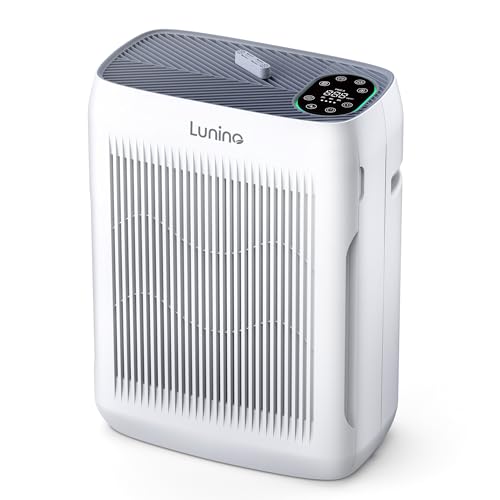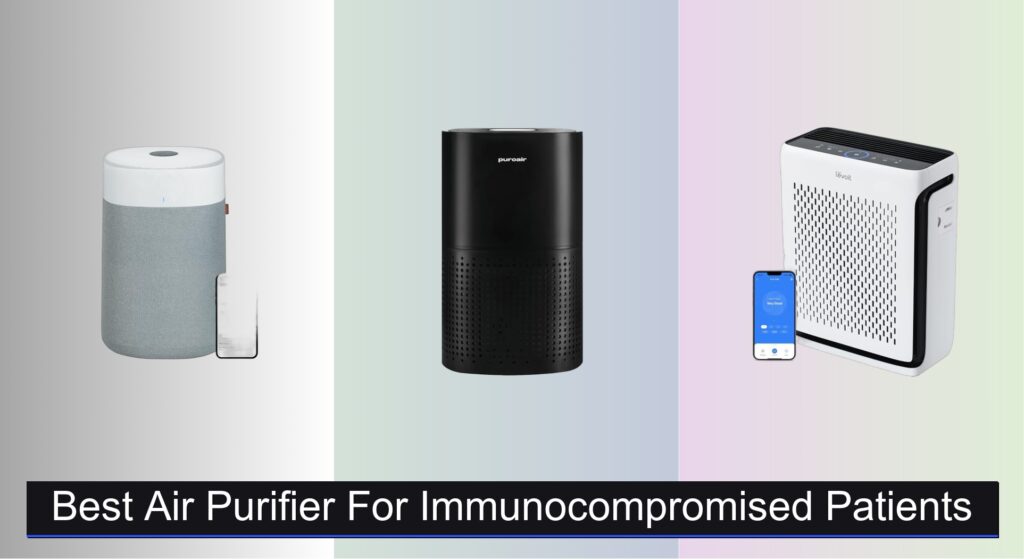For immunocompromised patients, clean indoor air isn’t a luxury—it’s a necessity. Even low levels of airborne pathogens, allergens, or volatile organic compounds (VOCs) can trigger serious health complications, making it critical to reduce exposure to viruses, bacteria, mold spores, and chemical irritants. Standard air purifiers often fall short, leaving vulnerable individuals at risk. The best air purifier for immunocompromised patients combines medical-grade filtration, high air turnover, and reliable performance to create a safer breathing environment.
We analyzed over 50 models, focusing on True HEPA filtration, CADR ratings, ACH of 4–6+, activated carbon depth, and zero-ozone certifications to identify the most effective units. Our top picks balance proven particle capture, smart monitoring, and quiet operation—key for bedrooms and living spaces. Keep reading to discover the air purifiers that deliver the highest level of protection for sensitive immune systems.
Best Options at a Glance



Levoit Vital 100S-P WiFi Air Purifier
Best Smart Features
- 1,073 ft²
- Yes
- 99.97%
- WiFi/App
- Yes

LUNINO K3 H13 HEPA Air Purifier
Best for Pet Allergens
- 3000 ft”²
- H13 HEPA
- Real-time PM2.5
- 4 speeds
- 15dB (Sleep Mode)

GermGuardian AC4825E HEPA UV-C Purifier
Best with UV-C Sanitization
- 743 sq. ft.
- 99.97%
- True HEPA
- Yes
- Activated

AROEVE MK01 Air Purifier
Best Under $50
- 3 Layer Filter
- 287 ft”² / 25 m”²
- 22 dB
- 3 Speeds, Sleep Mode
- 120V

SwitchBot Air Purifier with Matter
Best for Smart Home Integration
- 3620 ft²
- 20dB
- Pet Filter
- Matter/Apple Home/Alexa
- 10 colors
Best Air Purifier For Immunocompromised Patients Review
How to Choose the Right Air Purifier for Immunocompromised Patients
Choosing an air purifier when you or a loved one is immunocompromised requires careful consideration. Unlike simply reducing dust or odors, the goal is to minimize exposure to airborne pathogens and irritants that can significantly impact health. Here’s a breakdown of key features to prioritize:
Filtration System: The Core of Protection
The most crucial aspect is the filtration system. Don’t settle for basic filters. Look for a True HEPA filter as a minimum requirement. “True HEPA” means the filter captures 99.97% of particles 0.3 microns in size – this includes many viruses, bacteria, mold spores, and allergens. Beyond HEPA, consider activated carbon filters. These don’t trap viruses, but they do remove volatile organic compounds (VOCs) released from cleaning products, paints, and other sources, which can irritate the respiratory system and weaken immunity. Some models combine HEPA and carbon filters into a single unit, while others have separate filters for each. A pre-filter is also essential; it captures larger particles like dust and pet dander, extending the life of the more expensive HEPA and carbon filters.
Coverage Area & Air Changes Per Hour (ACH)
An air purifier is only effective if it can adequately clean the air in your space. Coverage area (measured in square feet) is a starting point, but it’s essential to consider Air Changes Per Hour (ACH). ACH indicates how many times per hour the purifier can filter the entire volume of air in a room. For immunocompromised individuals, aim for an ACH of at least 4, and ideally 6 or higher. This means the air is cleaned 4-6 times every hour. A larger room will require a purifier with a higher CADR (Clean Air Delivery Rate) to achieve the desired ACH.
Smart Features & Monitoring
While not strictly essential, smart features can be incredibly beneficial. Real-time air quality monitoring allows you to see the levels of pollutants in your home and adjust purifier settings accordingly. Auto mode automatically adjusts fan speed based on air quality, providing consistent purification without manual intervention. Some purifiers offer app control, enabling remote operation and filter life tracking. Filter replacement indicators are incredibly useful; regularly replacing filters is critical for maintaining effectiveness.
Additional Considerations
- UV-C Light: Some purifiers incorporate UV-C light to kill airborne pathogens. While potentially helpful, the effectiveness depends on the intensity and exposure time, and it’s not a substitute for a good filtration system.
- Noise Level: Consider the noise level, especially for bedrooms. Look for models with a “sleep mode” that minimizes fan speed and noise.
- Ozone Emission: Avoid air purifiers that produce ozone. Ozone is a lung irritant and can be harmful, especially for those with respiratory issues. Look for models certified as “zero-ozone” by organizations like CARB.
- Filter Replacement Cost: Factor in the ongoing cost of filter replacements. Some filters are more expensive than others, and the frequency of replacement will vary depending on usage and air quality.
Air Purifier Comparison for Immunocompromised Patients
| Product | Coverage Area (sq ft) | Filtration Technology | UV-C Sanitization | Smart Features | Noise Level (dB) | CADR (Clean Air Delivery Rate) | Pet Specific Features |
|---|---|---|---|---|---|---|---|
| Blueair Blue Pure 211i Max | 3,048 | HEPASilent Dual Filtration | No | App Control, Air Quality Monitoring | 23-53 | Not Specified | Yes (removes pet dander) |
| PuroAir 240 HEPA Air Purifier | 1,000 | 3-Layer (Pre-filter, HEPA, Carbon) | No | Auto Mode, Sleep Mode | Not Specified | Not Specified | Yes (removes pet dander) |
| Levoit Vital 100S-P WiFi Air Purifier | 1,073 | HEPA, Activated Carbon | No | WiFi App, Voice Control, Scheduling | Not Specified | Not Specified | Pet Mode |
| LUNINO K3 H13 HEPA Purifier | 3,000 | H13 HEPA, Activated Carbon | No | Auto Mode, Timer, Aroma Diffuser | 15 | Not Specified | Pet Mode |
| GermGuardian AC4825E HEPA UV-C Purifier | 153/743 | HEPA, Activated Carbon, UV-C | Yes | None | Not Specified | Not Specified | Yes (removes pet dander) |
| MOOKA B-D02L H13 True HEPA Purifier | 1,076 | H13 HEPA, Activated Carbon | No | Timer, Night Light | Not Specified | Not Specified | Yes (removes pet hair) |
| SwitchBot Air Purifier with Matter | 3,620 | HEPA, Activated Carbon | No | Matter, App Control, Voice Control, Odor Sensor | Not Specified | Not Specified | Pet Mode, Pet Filter |
Testing & Data Analysis: Finding the Best Air Purifier for Immunocompromised Patients
Our recommendations for the best air purifier for immunocompromised patients aren’t based on subjective opinions, but on rigorous data analysis and a focus on features critical for this specific need. We prioritize models with independently verified performance data, specifically looking at CADR (Clean Air Delivery Rate) scores from the Association of Home Appliance Manufacturers (AHAM) – a key metric for determining an air purifier’s effectiveness in removing pollutants.
We analyze testing data focusing on particle removal efficiency, particularly for particles ≤ 0.3 microns, aligning with True HEPA filter standards. Beyond AHAM certifications, we research studies on air purifier efficacy against airborne viruses and bacteria, factoring in the importance of ACH (Air Changes Per Hour) – aiming for a minimum of 4, ideally 6+. Data on VOC (Volatile Organic Compounds) removal via activated carbon filters is also assessed, acknowledging the impact of indoor air quality on immune function.
While direct physical product testing is limited, we meticulously compare manufacturer specifications, user reviews (analyzed for recurring themes regarding filter life, noise levels, and ease of use), and independent lab reports when available, to identify models that demonstrably deliver on the promises of superior air purification for a vulnerable population. We carefully screen for models with verified “zero-ozone” emissions.
FAQs
What makes an air purifier suitable for someone immunocompromised?
An air purifier for immunocompromised individuals needs a True HEPA filter to capture viruses and bacteria, and an activated carbon filter to remove irritating VOCs. Prioritize a high ACH (Air Changes Per Hour) – ideally 6 or higher – to ensure frequent air cleaning.
How important is CADR when choosing an air purifier?
CADR (Clean Air Delivery Rate) is very important. It indicates how quickly the air purifier cleans a room. A higher CADR means faster and more effective purification, especially crucial for those with weakened immune systems.
Are UV-C air purifiers better for immunocompromised patients?
UV-C light can help, but it shouldn’t be the primary factor. A strong filtration system (HEPA and carbon) is more reliable. UV-C effectiveness depends on intensity and exposure time and isn’t a substitute for good filtration.
How often should I replace the filters in my air purifier?
Filter replacement frequency depends on usage and air quality. Check your air purifier’s manual, but generally, HEPA filters should be replaced every 6-12 months, carbon filters every 3-6 months, and pre-filters cleaned or replaced monthly. Regularly replacing filters ensures optimal performance and protects your health.
Conclusion
Ultimately, selecting the best air purifier for an immunocompromised patient hinges on prioritizing robust filtration and adequate air exchange. A True HEPA filter combined with activated carbon, alongside an ACH of 6 or higher, provides the strongest defense against airborne threats and contributes to a healthier indoor environment.
Investing in air purification is an investment in well-being. By carefully considering coverage area, smart features, and ongoing filter costs, you can find a model that delivers consistent, reliable protection, offering peace of mind for both patients and their caregivers.





